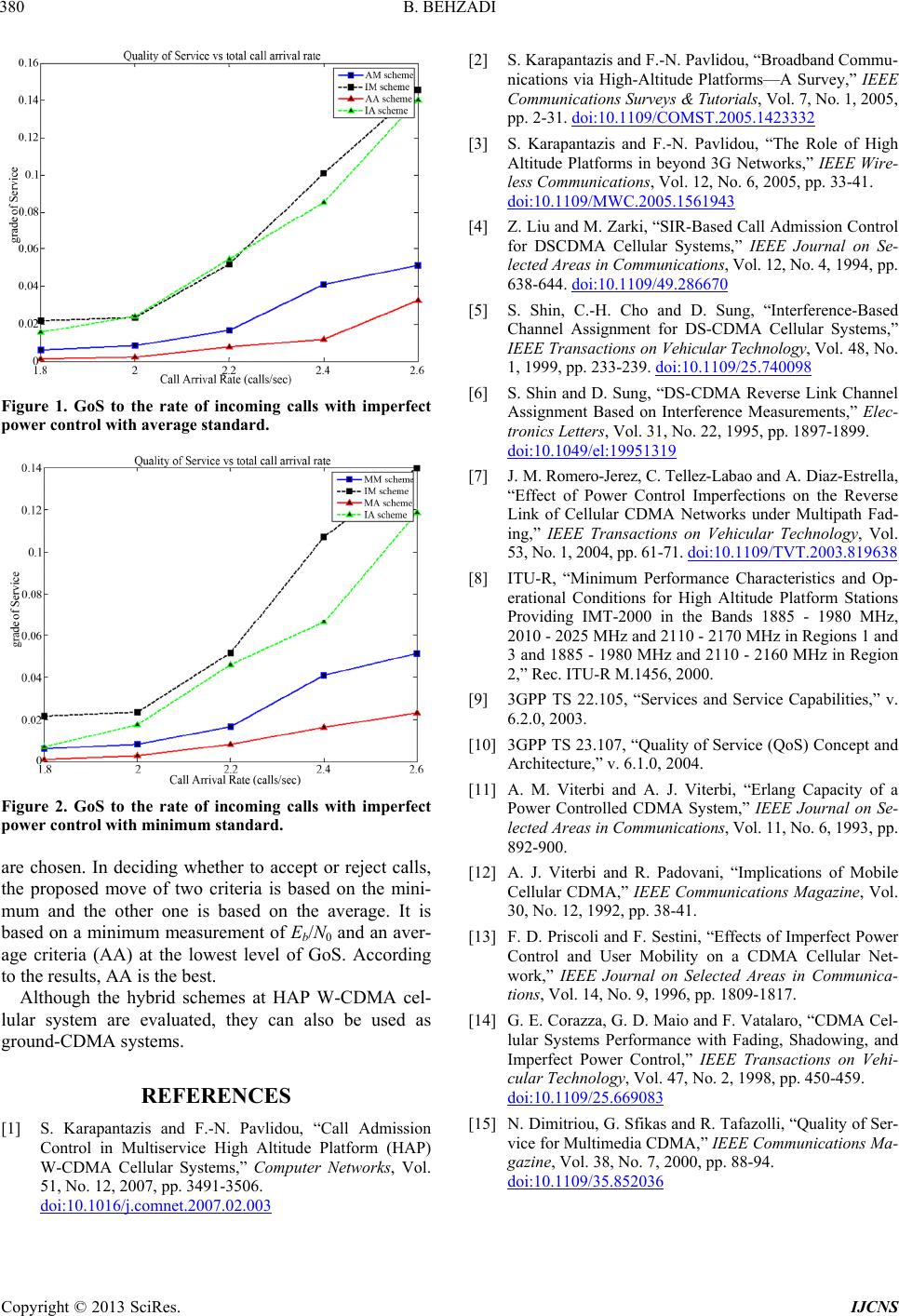
B. BEHZADI
Copyright © 2013 SciRes. IJCNS
380
[2] S. Karapantazis and F.-N. Pavlidou, “Broadband Commu-
nications via High-Altitude Platforms—A Survey,” IEEE
Communications Surveys & Tutorials, Vol. 7, No. 1, 2005,
pp. 2-31. doi:10.1109/COMST.2005.1423332
[3] S. Karapantazis and F.-N. Pavlidou, “The Role of High
Altitude Platforms in beyond 3G Networks,” IEEE Wire-
less Communications, Vol. 12, No. 6, 2005, pp. 33-41.
doi:10.1109/MWC.2005.1561943
[4] Z. Liu and M. Zarki, “SIR-Based Call Admission Control
for DSCDMA Cellular Systems,” IEEE Journal on Se-
lected Areas in Communications, Vol. 12, No. 4, 1994, pp.
638-644. doi:10.1109/49.286670
[5] S. Shin, C.-H. Cho and D. Sung, “Interference-Based
Channel Assignment for DS-CDMA Cellular Systems,”
IEEE Transactions on Vehicular Technology, Vol. 48, No.
1, 1999, pp. 233-239. doi:10.1109/25.740098
[6] S. Shin and D. Sung, “DS-CDMA Reverse Link Channel
Assignment Based on Interference Measurements,” Elec-
tronics Letters, Vol. 31, No. 22, 1995, pp. 1897-1899.
doi:10.1049/el:19951319
Figure 1. GoS to the rate of incoming calls with imperfect
power control with average standard.
[7] J. M. Romero-Jerez, C. Tellez-Labao and A. Diaz-Estrella,
“Effect of Power Control Imperfections on the Reverse
Link of Cellular CDMA Networks under Multipath Fad-
ing,” IEEE Transactions on Vehicular Technology, Vol.
53, No. 1, 2004, pp. 61-71. doi:10.1109/TVT.2003.819638
[8] ITU-R, “Minimum Performance Characteristics and Op-
erational Conditions for High Altitude Platform Stations
Providing IMT-2000 in the Bands 1885 - 1980 MHz,
2010 - 2025 MHz and 2110 - 2170 MHz in Regions 1 and
3 and 1885 - 1980 MHz and 2110 - 2160 MHz in Region
2,” Rec. ITU-R M.1456, 2000.
[9] 3GPP TS 22.105, “Services and Service Capabilities,” v.
6.2.0, 2003.
[10] 3GPP TS 23.107, “Quality of Service (QoS) Concept and
Architecture,” v. 6.1.0, 2004.
[11] A. M. Viterbi and A. J. Viterbi, “Erlang Capacity of a
Power Controlled CDMA System,” IEEE Journal on Se-
lected Areas in Communications, Vol. 11, No. 6, 1993, pp.
892-900.
Figure 2. GoS to the rate of incoming calls with imperfect
power control with minimum standard.
are chosen. In deciding whether to accept or reject calls,
the proposed move of two criteria is based on the mini-
mum and the other one is based on the average. It is
based on a minimum measurement of Eb/N0 and an aver-
age criteria (AA) at the lowest level of GoS. According
to the results, AA is the best.
[12] A. J. Viterbi and R. Padovani, “Implications of Mobile
Cellular CDMA,” IEEE Communications Magazine, Vol.
30, No. 12, 1992, pp. 38-41.
[13] F. D. Priscoli and F. Sestini, “Effects of Imperfect Power
Control and User Mobility on a CDMA Cellular Net-
work,” IEEE Journal on Selected Areas in Communica-
tions, Vol. 14, No. 9, 1996, pp. 1809-1817.
Although the hybrid schemes at HAP W-CDMA cel-
lular system are evaluated, they can also be used as
ground-CDMA systems.
[14] G. E. Corazza, G. D. Maio and F. Vatalaro, “CDMA Cel-
lular Systems Performance with Fading, Shadowing, and
Imperfect Power Control,” IEEE Transactions on Vehi-
cular Technology, Vol. 47, No. 2, 1998, pp. 450-459.
doi:10.1109/25.669083
REFERENCES
[15] N. Dimitriou, G. Sfikas and R. Tafazolli, “Quality of Ser-
vice for Multimedia CDMA,” IEEE Communications Ma-
gazine, Vol. 38, No. 7, 2000, pp. 88-94.
doi:10.1109/35.852036
[1] S. Karapantazis and F.-N. Pavlidou, “Call Admission
Control in Multiservice High Altitude Platform (HAP)
W-CDMA Cellular Systems,” Computer Networks, Vol.
51, No. 12, 2007, pp. 3491-3506.
doi:10.1016/j.comnet.2007.02.003